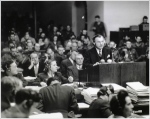The extraordinarily talented Tony Mauro has a piece well worth reading entitled, Sotomayor Sees Return to Trial Courts After Retirement, Supreme Court Brief (November 17, 2014) (h/t How Appealing). In the article, Mr. Mauro quotes the fascinating Justice Sonia Sotomayor:
“Out of my mouth came, ‘When and if I retire, I’m going to go back to the district court,” Sotomayor said, recalling her six years in the 1990s as a judge on the U.S. District Court for the Southern District of New York. “Why would I want to go do what I’ve been doing for however many years it’s been on the appellate court and the Supreme Court?”
She continued, “I want to go back to my first love. And the district court is a very different and exciting place. At least for me, it was the formative experience for preparing me for the [Supreme] court.” (Her remarks are at the 1:13 mark of the conversation, available on YouTube.)
Good for the Justice. I hope she means it.
But, let’s go the Justice one better. Instead of going off to Salzburg or wherever over the summers to teach (and engage in all manner of other pleasant things), why don’t the Justices resolve to try cases to juries in the United States District Courts. And I mean every Justice, even the ones who think they are too smart to set forth in a trial courtroom.
Go to the sticks or some place where the Justice doesn’t know the local legal culture and take a case to a jury trial–a place and a case that would make the esteemed feel uncomfortable and require him or her to rub shoulders with real trial lawyers. Try a criminal case with several defendants involving a drug conspiracy and a bunch of statements raising Federal Rule of Evidence 801(d)(2)(E) problems, or a patent case involving a magic new manure spreader and requiring jury instructions that don’t read like Supreme Court opinions, or a contract case for the production of complex software where no one has yet to figure out what the judge is supposed to do during trial regarding the terms of the contract as contrasted with what the jury is supposed to do with those same terms during deliberations. Draft a verdict form, prepare jury instructions, make rulings on evidence, do a jury orientation, hold bench conferences, decide whether you want a court reporter or digital audio, determine whether to allow recross, decide if lawyers may move freely about the courtroom without your permission, conduct a voir dire and rule on whether the lawyers get to ask questions too, and so forth. Oh, and over the noon hour, conduct two or three sentencing hearings in criminal cases.
Such a practice–trying real cases to real juries with real lawyers in real places–would expand exponentially the horizons of all the Justice (even Sotomayor who spent only six years as trial judge–a mere blink of time for most of us). It would also give the hard-working and long-suffering judges of the Courts of Appeal an opportunity to reverse a Supreme Court Justice for making perfectly idiotic rookie mistakes–and that would be very good for the souls of the rest of us and the Justices too.
RGK








